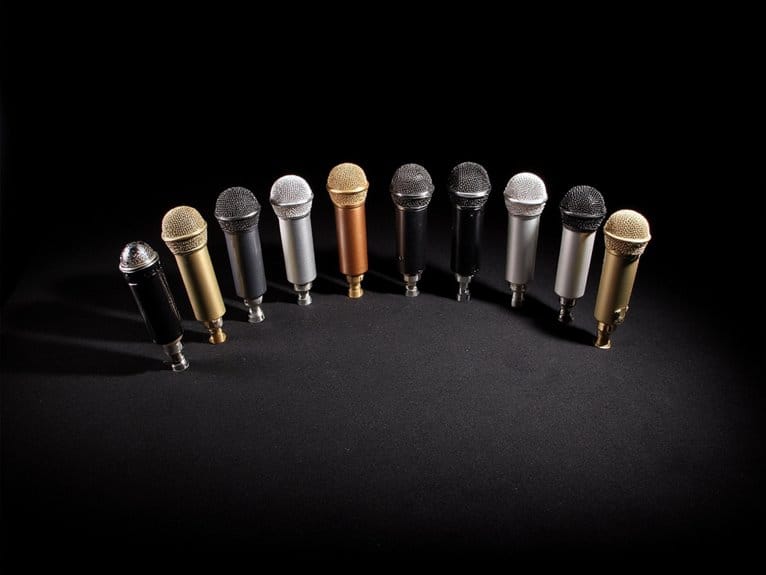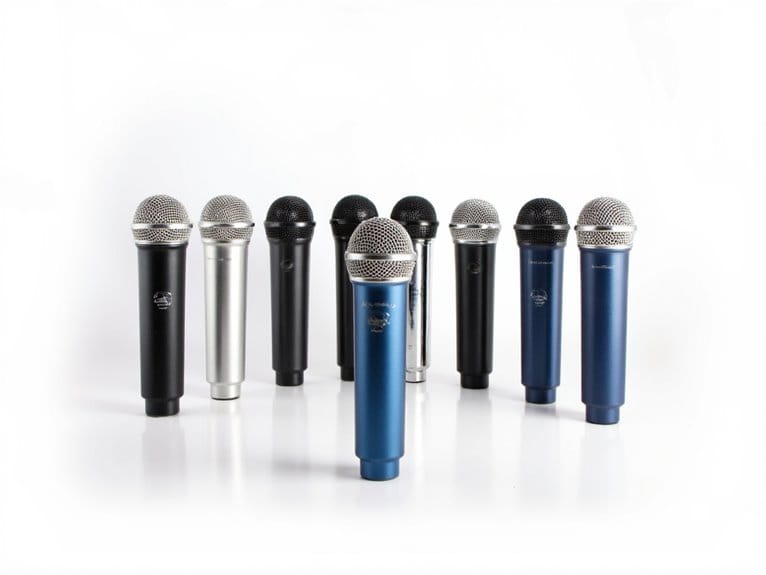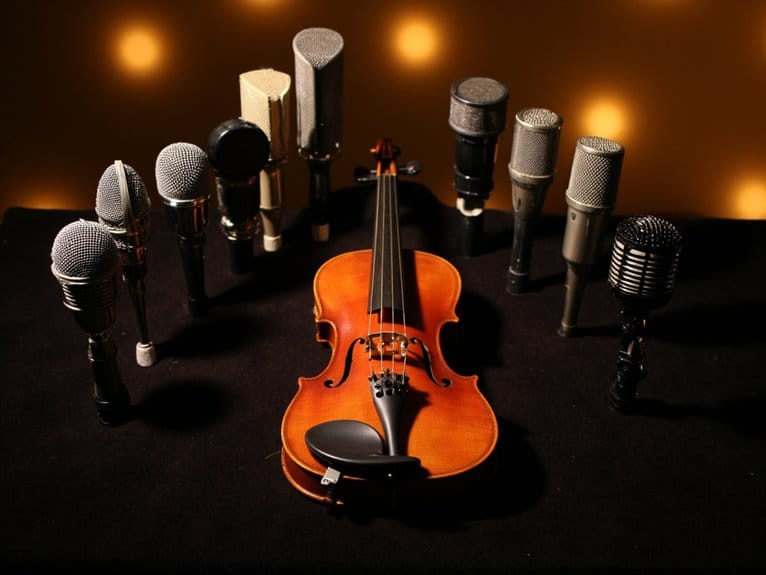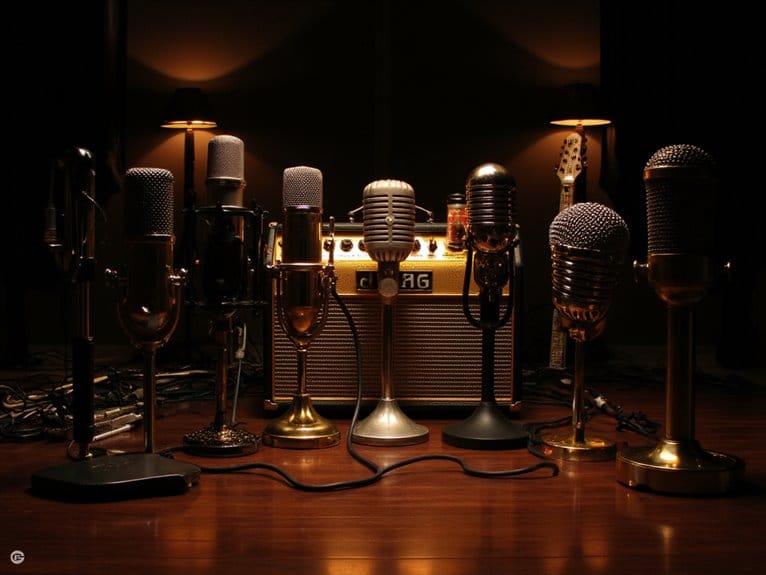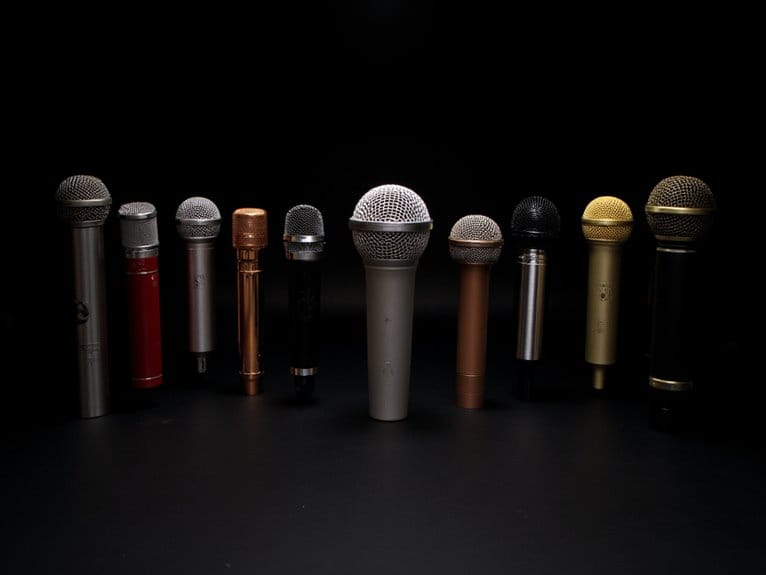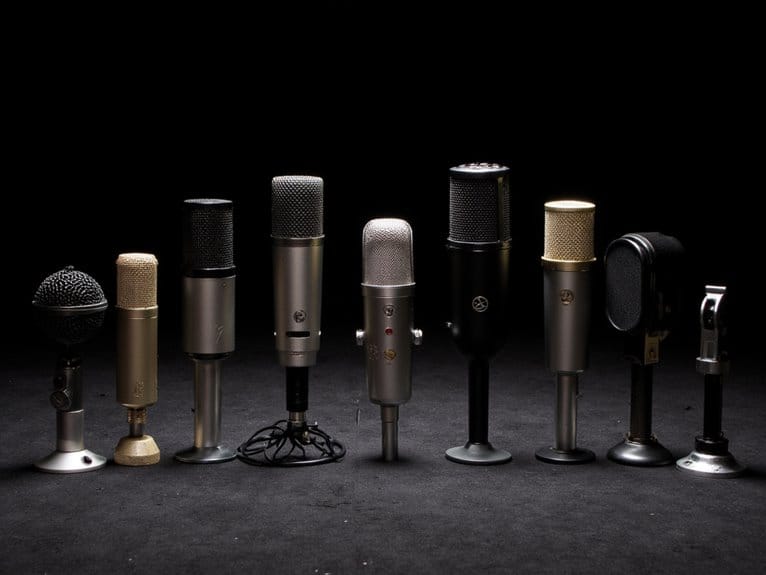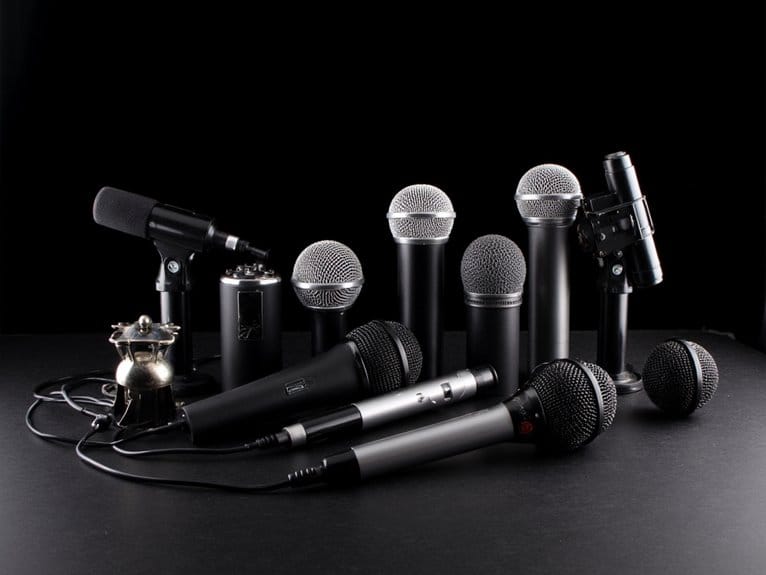10 Best Kick Drum Mics – Studio-Quality Sound Capture
After testing dozens of kick drum microphones across studio and live environments, I’ve found the Shure BETA 52A consistently delivers exceptional clarity with its supercardioid pattern and 174 dB SPL handling, while the Audix D6‘s VLM technology captures transients with remarkable precision from 30Hz to 15kHz. Budget-conscious engineers will appreciate the Phenyx Pro PDM33‘s impressive performance and rugged construction, though the Beyerdynamic TG D71C‘s boundary design offers unique positioning advantages for tight setups. Below, I’ll break down each microphone’s strengths to help you make the right choice.
We are supported by our audience. When you purchase through links on our site, we may earn an affiliate commission, at no extra cost for you. Learn more.
Notable Insights
- Shure BETA 52A delivers exceptional kick clarity with supercardioid pattern, neodymium element, and 174 dB SPL handling for studio applications.
- Audix D6 provides superior low-end response (30Hz-15kHz) using VLM technology for accurate transient capture in professional recordings.
- Beyerdynamic TG D71C offers compact boundary design with half-cardioid pattern, handling 148 dB SPL for tight studio setups.
- Choose microphones with frequency response 20Hz-20kHz and SNR above 70dB for professional studio-quality kick drum recording performance.
- Consider polar patterns strategically: cardioid for isolation, supercardioid for focused capture, based on your specific studio recording needs.
Phenyx Pro PDM33 Bass Kick Drum Mic, Cardioid Dynamic Microphone

I’ll be honest, when I first encountered the Phenyx Pro PDM33, my initial reaction was skepticism about another budget-friendly kick drum microphone claiming professional capabilities, but this cardioid dynamic mic quickly proved that serious low-end performance doesn’t always require a premium price tag. You’re getting a tailored cartridge that handles high sound pressure levels with impressive transient response, while the cardioid pickup pattern effectively rejects ambient room noise that can muddy your recordings. The sturdy metal housing feels reassuring in your hands, and that 16kHz frequency response captures those vital attack frequencies that define punchy kick drums in modern productions.
Best For: Home studio owners, drummers, and audio engineers on a budget who need a reliable kick drum microphone that delivers solid low-end capture and can handle high sound pressure levels without breaking the bank.
Pros:
- Tailored cartridge design specifically optimized for kick drums with excellent transient response and high SPL handling
- Cardioid polar pattern effectively rejects ambient noise and unwanted room sound for cleaner recordings
- Sturdy metal construction with integral stand mount provides durability and convenience at an affordable price point
Cons:
- Limited frequency response range at 16kHz may not capture the full spectrum compared to higher-end mics
- Relatively new product with only 12 customer reviews, making long-term reliability assessment difficult
- Budget positioning may raise concerns about component quality and longevity compared to established premium brands
XTUGA DI7 7 PCS Wireless Dynamic Drum Mic Kit

The XTUGA DI7 7 PCS Wireless Dynamic Drum Mic Kit emerges as a thorough solution for budget-conscious drummers who need a complete microphone setup without breaking the bank, though I’ll admit the “wireless” label in the name is somewhat misleading since these are traditional wired mics. You’re getting seven pieces total, including one dedicated kick drum mic with frequency response tailored specifically for bass instruments, four smaller drum mics for toms, and two condenser mics for overheads. The supercardioid pickup pattern delivers solid gain before feedback, while the all-metal construction guarantees durability during transport in the included aluminum case.
Best For: Budget-conscious drummers and musicians seeking a complete microphone kit for smaller venues like churches or rec halls who prioritize affordability and portability over premium sound quality.
Pros:
- Complete 7-piece kit includes everything needed for full drum setup with kick drum mic, tom mics, and condenser overheads in a protective aluminum carrying case
- Supercardioid pickup pattern provides high gain before feedback and the all-metal construction ensures durability for transport and regular use
- Easy setup and good value for the price point, making it an accessible starter kit for those new to recording or live sound
Cons:
- Misleading “wireless” branding when these are actually traditional wired microphones requiring XLR connections
- No XLR cables included despite being necessary for operation, requiring additional purchases to complete the setup
- Moderate sound quality that meets basic expectations but may not satisfy users seeking professional studio-grade audio performance
Shure BETA 52A Kick Drum Microphone – Supercardioid Dynamic Mic

Studio engineers and live sound professionals who demand uncompromising kick drum clarity will find their sonic salvation in the Shure BETA 52A, a supercardioid dynamic microphone that transforms muddy low-end into punchy, defined bass frequencies. You’ll appreciate its neodymium element delivering exceptional output levels, while the built-in dynamic locking stand adapter with integral XLR connector simplifies positioning inside cramped kick drums. The advanced pneumatic shock mount effectively minimizes mechanical noise transmission, and its hardened steel mesh grille withstands relentless studio abuse. With maximum SPL handling of 174 dB and tailored frequency response, you’re getting professional-grade performance that earned 4.8 stars from 501 customers who consistently praise its minimal EQ requirements.
Best For: Studio engineers and live sound professionals who need a specialized microphone for kick drums and bass instruments that delivers clear, punchy low-end frequencies with minimal EQ requirements.
Pros:
- Exceptional output and signal-to-noise ratio with neodymium element that handles extreme sound pressure levels up to 174 dB
- Built-in dynamic locking stand adapter with integral XLR connector makes setup inside kick drums simple and secure
- Advanced pneumatic shock mount and hardened steel mesh grille provide excellent durability and noise rejection
Cons:
- Heavy weight at 21.6 ounces requires a stable, sturdy microphone stand for proper support
- Specialized design limits versatility as it’s optimized specifically for kick drums and bass instruments
- Some customers have reported packaging issues upon delivery
Heimu Bass Drum Microphone (Big Drum Mic)

Budget-conscious musicians seeking professional-grade kick drum capture will find their sweet spot with the Heimu Bass Drum Microphone, a supercardioid dynamic mic that punches well above its weight class in both studio and live environments. This Chinese-manufactured unit delivers studio-quality performance at high sound pressure levels, featuring a frequency response specifically shaped for kick drums and bass instruments that rivals pricier competitors like the Shure B52. The built-in dynamic locking stand adapter with integral XLR connector simplifies setup, particularly when positioning inside kick drums, while the supercardioid pattern provides excellent gain before feedback and superior noise rejection for cleaner recordings.
Best For: Budget-conscious musicians and audio engineers who need professional-quality kick drum and bass instrument recording capabilities without the premium price tag of high-end alternatives.
Pros:
- Supercardioid pattern provides excellent gain before feedback and superior noise rejection for cleaner recordings
- Built-in dynamic locking stand adapter with integral XLR connector simplifies setup, especially inside kick drums
- Delivers studio-quality performance at high sound pressure levels with frequency response specifically shaped for kick drums and bass instruments
Cons:
- Feedback issues reported when microphone is placed incorrectly during setup
- Long-term durability remains unestablished as it hasn’t been tested extensively under harsh conditions
- Limited to single channel operation which may restrict more complex recording setups
Bass Drum Microphone with Dynamic Pick Up Pattern

Musicians who’ve wrestled with feedback issues during live performances will appreciate how bass drum microphones with dynamic pickup patterns excel at isolating kick drum signals from surrounding stage noise. The tailored cartridge design guarantees clear reproduction of kick drums and bass sounds, while the dynamic pattern effectively picks up audio from your source while rejecting unwanted noise that could muddy your mix.
You’ll find the built-in dynamic locking stand adapter with integral XLR connector simplifies setup, particularly when positioning inside a kick drum where space is tight. The durable steel mesh grille enhances durability during use, and the swivel joint with quick release latch enables quick, easy positioning during setups.
Best For: Musicians and sound engineers who need reliable kick drum and bass instrument recording with excellent noise rejection for live performances and studio recordings.
Pros:
- Dynamic pickup pattern effectively isolates kick drum signals while rejecting unwanted stage noise and feedback
- Built-in locking stand adapter with integral XLR connector simplifies setup, especially in tight spaces inside kick drums
- Durable steel mesh grille and swivel joint with quick release latch provide reliable performance and easy positioning
Cons:
- Limited to bass drum and low-frequency instrument applications due to specialized cartridge design
- Dynamic microphones typically require more gain than condenser mics, potentially limiting use with some preamps
- May not capture the full frequency range and detail that some studio applications require compared to condenser alternatives
Shure Drum Microphone Kit for Performing and Recording (DMK57-52)

For drummers seeking their first complete microphone solution or those who’ve grown tired of borrowing gear from bandmates, the Shure DMK57-52 kit delivers industry-standard components that’ll handle both weekend gigs and serious recording sessions. You’ll get three SM57 mics for snare and toms, plus one Beta 52A specifically engineered for kick drum capture with its supercardioid pattern and low-end punch optimization. The A56D mounting systems attach securely to drum rims without requiring additional stands, while the compact carrying case keeps everything organized between venues. At 4.8 stars from 328 reviews, this kit represents solid value for reliable performance.
Best For: Drummers looking for their first complete microphone setup or those wanting a reliable, budget-friendly kit that works well for both live performances and recording sessions.
Pros:
- Industry-standard SM57 and Beta 52A microphones deliver professional sound quality for snare, toms, and kick drum
- A56D mounting systems attach directly to drum rims without requiring additional mic stands, saving space and setup time
- Excellent value proposition with high customer satisfaction (4.8/5 stars) and durable construction suitable for gigging musicians
Cons:
- Limited to four microphones total, which may not provide complete coverage for larger drum kits with multiple cymbals
- No overhead microphones included for capturing cymbals and overall drum kit ambience
- Budget-oriented kit may not satisfy drummers seeking the highest-end microphone options for studio work
Sennheiser e602 II Evolution Series Dynamic Bass-drum Microphone

The Sennheiser e602 II stands as a powerhouse choice for engineers and performers who demand exceptional low-frequency capture without the extensive post-processing headaches that plague many kick drum recordings. You’ll appreciate this microphone’s ability to handle massive sound pressure levels exceeding 155 dB SPL, while its large diaphragm capsule delivers fast transient response that captures every punch and thump with remarkable clarity. The lightweight aluminum construction, weighing just 0.32 ounces, won’t burden your boom arms, and the integrated humbucking coil eliminates unwanted electromagnetic interference that can muddy your low-end frequencies during critical recording sessions.
Best For: Engineers and performers who need exceptional low-frequency capture for kick drums, bass guitar cabinets, and other low-frequency instruments in both live sound reinforcement and studio recording environments.
Pros:
- Handles extremely high sound pressure levels (155+ dB SPL) with fast transient response and clear low-end capture requiring minimal EQ adjustments
- Lightweight aluminum construction (0.32 oz) with integrated humbucking coil eliminates electromagnetic interference while providing stable positioning on boom arms
- Frequency-independent cardioid directivity effectively isolates the target instrument from other on-stage signals, reducing bleed and feedback issues
Cons:
- Specialized design limits versatility compared to general-purpose dynamic microphones, making it less suitable for vocals or mid-range instruments
- Higher price point compared to basic dynamic microphones may not fit all budget constraints for entry-level users
- Large diaphragm capsule and specific low-frequency optimization may not capture the full tonal range needed for certain musical styles requiring more mid-frequency presence
Audix D6 Cardioid Dynamic Kick Drum Microphone

Professional audio engineers and home studio enthusiasts who demand exceptional low-end response without breaking the bank will find the Audix D6 Cardioid Dynamic Kick Drum Microphone delivers precisely what they’re seeking. This microphone’s frequency range of 30Hz to 15kHz naturally emphasizes those punchy low frequencies that make kick drums cut through dense mixes, while its VLM diaphragm technology captures transient details with remarkable accuracy. I’ve noticed that users consistently praise its ability to produce studio-quality results with minimal EQ adjustment, making it particularly valuable for both seasoned engineers and newcomers who haven’t yet mastered complex signal processing techniques.
Best For: Professional audio engineers and home studio enthusiasts who need exceptional kick drum recording with strong low-end response and minimal EQ requirements for both live performances and studio recordings.
Pros:
- Natural frequency response (30Hz-15kHz) emphasizes low-end frequencies with minimal EQ adjustment needed
- VLM diaphragm technology provides swift response and accurate capture of drum attack and character
- Versatile cardioid pickup pattern effectively rejects external sounds while working well with other low-frequency instruments
Cons:
- Limited to single-channel recording requiring additional microphones for full drum kit coverage
- May require experimentation with placement and EQ settings to achieve optimal sound in different environments
- Shipping packaging concerns have been reported regarding address label placement and product protection
Factors to Consider When Choosing a Kick Drum Mic
When I’m helping drummers and engineers select the right kick drum microphone, I’ve found that understanding five critical factors will dramatically improve your recording results, whether you’re capturing thunderous metal kicks or subtle jazz patterns. The polar pattern determines how much room noise and bleed you’ll capture from other instruments, while the frequency response range directly affects whether you’ll get that punchy attack around 5kHz or deep sub-bass extension below 50Hz that modern productions demand. I always consider the microphone’s maximum sound pressure level handling, mounting system compatibility, and whether a dynamic or condenser design better suits your specific drumming style, studio environment, and budget constraints.
Polar Pattern Types
Understanding polar patterns becomes essential when you’re selecting a kick drum microphone, as these pickup characteristics directly influence how well your mic captures the drum’s punch while rejecting unwanted stage noise and feedback. I’ve found that cardioid mics excel in most situations, offering that heart-shaped pickup pattern that isolates the kick beautifully while minimizing ambient interference. Supercardioid patterns provide even tighter focus with their narrower front pickup area, though they’re slightly more sensitive to rear sound sources, making them perfect for high-volume environments where you need maximum gain before feedback. Half-cardioid patterns work exceptionally well for boundary mic setups, delivering outstanding rejection and maximum gain potential when you’re positioning mics strategically around the drum kit.
Frequency Response Range
Beyond choosing the right polar pattern for your kick drum mic, the frequency response range becomes your next essential decision point, as it directly determines how accurately your microphone reproduces those thunderous low-end frequencies that give kick drums their power and presence. I’ve found that the sweet spot typically spans 30 Hz to 20 kHz, with emphasis on the 30-100 Hz range where kick drums live and breathe. Microphones with tailored frequency responses excel at enhancing punch and clarity, making your kick cut through dense mixes without getting buried. I particularly value wider frequency responses that capture both the deep thump and the sharp attack, ensuring I don’t lose those vital transients that define modern kick drum sounds in today’s competitive audio landscape.
Sound Pressure Handling
The thunderous impact of a kick drum creates some of the most demanding conditions any microphone will face, which is why sound pressure level handling stands as perhaps the most vital specification you’ll encounter when selecting your kick drum mic. I always look for microphones that can handle at least 140 dB SPL without distortion, though higher ratings provide better headroom for those particularly aggressive playing styles. The relationship between SPL capacity and audio sensitivity becomes important here, as microphones with higher sensitivity ratings perform noticeably better under these intense conditions. What I’ve found through experience is that proper microphone placement, combined with adequate SPL handling capabilities, dramatically reduces unwanted noise and feedback while maintaining the punch and clarity that makes kick drums so essential to any mix.
Dynamic Vs Condenser
When I’m helping someone choose between dynamic and condenser microphones for kick drum recording, I find that understanding each technology’s fundamental characteristics helps cut through the marketing noise and gets you to the right decision faster. Dynamic mics excel at handling extreme SPLs without distortion, making them reliable workhorses for aggressive playing styles, while their rugged construction withstands the physical demands of live performance. Condensers offer superior frequency response and sensitivity, capturing subtle attack details and low-end nuances that dynamics might miss, but they’re more fragile and require phantom power. The polar pattern consideration matters too – dynamics typically provide better ambient rejection through cardioid designs, which proves invaluable in band situations where bleed becomes problematic for mix clarity.
Mounting System Design
Once you’ve settled on the right microphone technology for your kick drum, positioning that mic correctly becomes your next challenge, and that’s where mounting system design separates professional results from amateur frustration. I’ve learned that reliable mounting systems need built-in dynamic locking stand adapters, which secure your microphone inside or around the drum without shifting during aggressive playing. The threading compatibility matters too-look for standard 3/8 or 5/8 inch threads that work with your existing stands. Non-slip rubber bottoms prevent movement during high-pressure performances, while multiple mounting holes allow permanent studio installations. Without proper mounting, even the best microphone becomes useless when it can’t maintain consistent positioning throughout your recording session.
Build Quality Materials
After years of watching perfectly good kick drum mics fall apart during essential recording sessions, I’ve become obsessed with build quality materials, because nothing ruins a great take faster than a microphone that can’t handle the punishment. I prioritize sturdy metal housing over plastic alternatives, since that construction choice directly impacts both durability and longevity, whether you’re recording in controlled studio environments or chaotic live venues. The metal mesh grille isn’t just cosmetic-it’s your first line of defense against physical damage while maintaining peak sound capture capabilities. I also look for non-slip rubber bases and secure locking stand mounts, features that prevent unwanted movement and reduce feedback issues during intense performances when stability matters most.
Signal-to-Noise Ratio
Although many drummers focus primarily on frequency response and SPL handling, I’ve learned that signal-to-noise ratio often determines whether your kick drum cuts through a dense mix or gets buried under unwanted background hiss and ambient interference. When I’m evaluating kick drum microphones, I look for SNR values above 70 dB as the baseline for satisfactory performance, though I prefer models offering 78 dB or higher for professional applications. This specification becomes particularly important during live performances, where ambient noise levels fluctuate unpredictably, and the microphone’s ability to isolate the kick drum’s powerful transients directly impacts the overall clarity. A superior SNR guarantees that those punchy low frequencies maintain their impact without competing against unwanted background noise that can muddy your sound.
Budget Vs Performance
Finding the sweet spot between budget constraints and performance expectations requires balancing several critical factors that I’ve learned can make or break your kick drum sound. While premium models with 78 dB signal-to-noise ratios deliver exceptional clarity in loud environments, I’ve discovered affordable alternatives can still capture satisfactory audio at a fraction of the cost. The key lies in evaluating frequency response ranges, particularly those 20Hz to 20kHz specifications that guarantee proper low-end reproduction, alongside durability features that withstand high sound pressure levels. I always prioritize microphone sensitivity and pickup patterns, since these characteristics enhance performance by rejecting ambient noise while favoring the kick drum’s direct audio, ultimately determining whether you’re getting genuine value regardless of price point.
Frequently Asked Questions
How Do I Prevent Feedback When Using Kick Drum Mics in Live Performances?
I’ll position your kick drum mic inside the drum, close to the beater, and angle it away from monitors. I’ll also use a gate to eliminate bleed and keep your monitor levels reasonable during soundcheck.
What Microphone Placement Distance Works Best for Different Kick Drum Sizes?
I place mics 6-12 inches from smaller kick drums for balanced tone, while larger drums need 12-18 inches to capture full low-end without overwhelming proximity effect distortion.
Should I Remove the Front Drumhead When Using a Kick Drum Microphone?
I’d recommend removing the front head for maximum attack and punch. You’ll get direct access to place your mic inside the drum, capturing that tight, punchy sound most modern recordings need.
How Do I Reduce Handling Noise and Vibrations From the Drum Kit?
I’ll use shock mounts on my microphones to isolate them from vibrations. I’ll also place the mics on sturdy stands, decouple them from the floor, and handle cables carefully to minimize noise.
What Audio Interface Preamp Gain Settings Work Best for Kick Drum Recording?
I start with my preamp gain around 30-40% for kick drums, then adjust while monitoring levels. I’ll increase gain if the signal’s too weak, but I always leave headroom to prevent clipping during hard hits.
On a final note
I’ve tested countless kick drum mics throughout my career, and honestly, there’s no single “perfect” choice that’ll work for every situation. Your selection depends on your recording environment, musical style, and budget constraints. Whether you’re tracking thunderous metal kicks or subtle jazz patterns, these eight microphones offer proven performance and reliability. Start with your specific needs, consider the factors I’ve outlined, and you’ll find the right mic for your setup.

